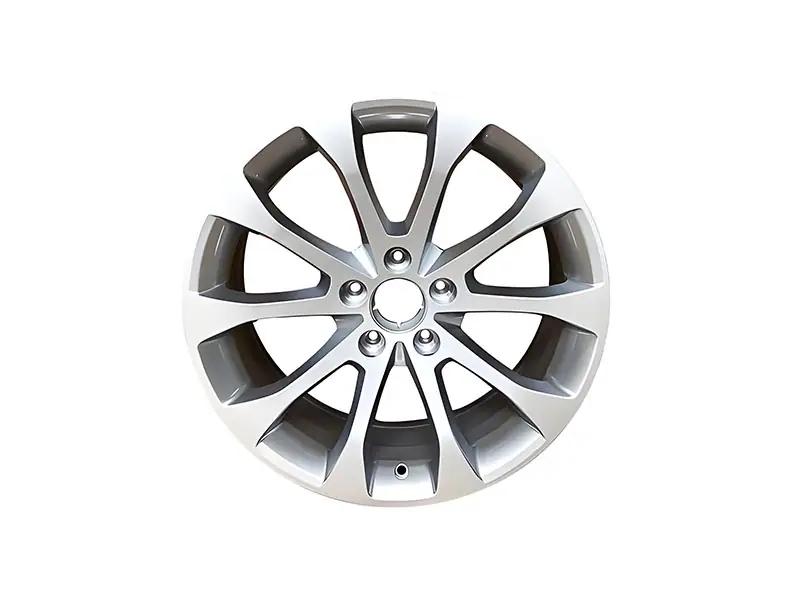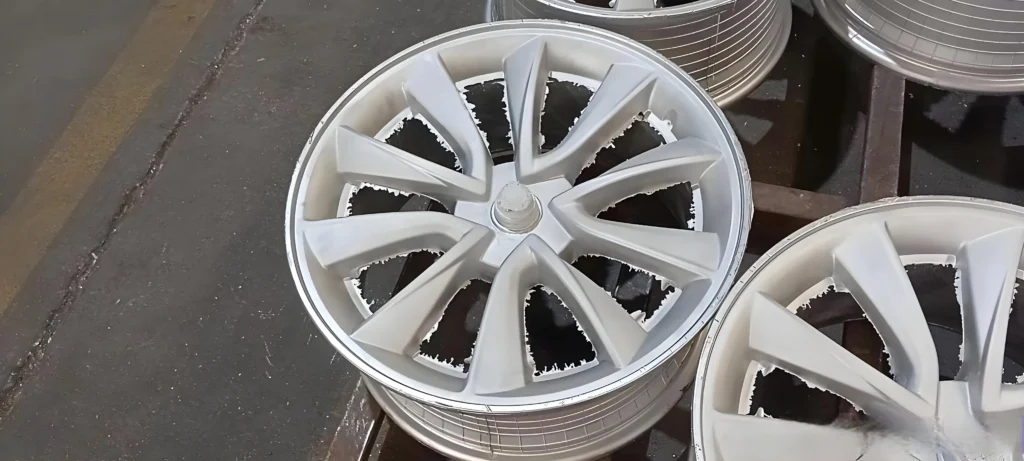Low pressure casting aluminum wheel hub crack formation causes and improvement measures
Date: 2025-01-27 Categories: Blog Views: 1362
Low-pressure casting Can achieve a high degree of mechanization and automation, increase productivity (10 ~ 15 type / h), it can also reduce many human factors that are detrimental to the production process, improve the rate of finished products, and greatly reduce the labor intensity of workers. However, the quality of low pressure casting by the process plan, process parameters, mold structure and manual operation and other factors, any design unreasonable or improper operation of the link may lead to low pressure casting defects. The generation of aluminum wheel cracks is an important factor that affects the production cost and productivity of enterprises. Therefore, it is particularly important to discuss the causes of cracks in low pressure casting aluminum wheels. Next, I will discuss with you in China low pressure casting plant casting aluminum Formation and elimination measures of cracks in automobile wheels.

What is a low-pressure cast wheel?
Low pressure casting wheels are manufactured by low pressure casting technology, which provides high density, high strength and good quality control. The process injects a liquid alloy into a mold at low pressure, where the alloy cools and solidifies. Low pressure casting produces wheels with high density, uniform structure, good strength and toughness, and is suitable for mass production.
The production process is divided into several steps: first, the liquid alloy is injected into a mold; next, the alloy is cooled and solidified; and finally, the wheel is completed through heat treatment, finishing and painting processes. This process reduces air bubbles and impurities, improves strength and precision, and enhances the safety of the wheel.
together withGravitational castingLow-pressure casting is more efficient and produces better product quality than low-pressure casting. Gravity casting relies on gravity to flow the metal, which can lead to uneven distribution, compromising quality and safety. Low-pressure casting controls the flow of aluminum alloy by applying pressure, ensuring wheel accuracy and strength.
As a result, low-pressure cast wheels are becoming increasingly important in automotive manufacturing, providing high efficiency, quality and safety.

Low-pressure casting wheel technology advantage and industrial value reshaping
Precision Manufacturing Revolution Driven by Mechanical Automation
Low-pressure casting technology through a high degree of mechanization and automation of production, to achieve a stable production capacity of 10 to 15 pieces per hour, compared with the traditional gravity casting efficiency increased by about 30%. its core principle is to use low-pressure gas (0.02-0.08MPa) will be the liquid aluminum alloy smoothly pressed into the mold cavity, to avoid the free flow of the metal liquid gravity casting caused by the volume of gas, oxidation slag and other problems. Take a new energy vehicle wheel mass production project as an example, through the introduction of fully automatic low pressure casting line, the product yield jumped from 82% to 96%, while the labor cost was reduced by 45%. the combination of mold temperature closed-loop control system and intelligent pressure sensors made the casting internal grain refinement to the micron level, and the dynamic bending fatigue life of the wheel hub exceeded one million cycles, which fully meets the requirements of lightweight and safety of high-end models. This fully meets the dual demands of lightweight and safety of high-end models.
Interdisciplinary Diagnosis of Crack Causes in Low-Pressure Casting Wheels
Deep correlation between crack morphology and failure mechanisms
In the production process of aluminum alloy wheels, the formation of cracks is often the result of the coupling of multiple factors such as material properties, structural design, and process parameters. According to fracture mechanics analysis, wheel cracks can be divided into three major types:
- Thermal cracking (solidification defects): It mostly occurs at the spoke-rim joint and manifests itself as a reticulated crack distributed along the grain boundaries. The essence is that the residual liquid metal between the dendritic skeleton at the end of solidification cannot withstand the contraction stress, and typical cases show that the probability of thermal cracking increases by 60% when the local cooling rate exceeds 4°C/s.
- Cold cracking (mechanical stress)The fracture is commonly found at the root of the hub flange, and the fracture shows typical brittle fracture characteristics. Failure analysis of a commercial vehicle hub showed that the solidified metal remaining in the lift tube during demolding caused the casting to be subjected to a tensile stress of more than 200 MPa, which directly triggered the penetrating crack.
- Stress corrosion cracking (environmental interaction): In coastal high humidity environments, residual stresses within the hub synergize with chloride ions, leading to the slow expansion of cracks along grain boundaries. Such cracks show a unique dendritic bifurcation morphology in microscopic observation.
Systematic analysis of key fracturing factors
1. Mechanical amplification of structural design flaws
- Stress concentration at sharp corners: If the radius of the inner fillet in the transition region of the wheel spoke is less than 3mm, the stress concentration factor (Kt) can reach 3.5-4.2, which is far more than the yield strength of A356-T6 aluminum alloy (220MPa). Simulation data of a sport wheel shows that after optimizing the R angle from 2mm to 5mm, the maximum equivalent stress is reduced from 315MPa to 185MPa.
- Wall thickness mutation effect: When the difference in wall thickness between neighboring areas exceeds 3:1, the thermal stress gradient generated during the cooling process can break through the material tensile strength limit. The fracture case of a lightweight wheel hub shows that the thickness of the rim-spoke joint decreased abruptly from 8mm to 3mm, resulting in a local stress peak of 280MPa.
2. Systemic risk of process parameter mismatch
- Narrow window of time to hold pressure: Holding time of less than 15 seconds leads to interruption of shrinkage and formation of shrinkage loosening, while more than 40 seconds creates mechanical resistance to solidification of metal in the ascending tube. A project DOE test confirmed that when the holding time is controlled in the range of 25-30 seconds, the cracking rate is reduced from 7.2% to 0.8%.
- Improper control of filling rateWhen the filling speed exceeds 120mm/s, the probability of turbulent gas rolls in the liquid metal is increased by 40%, and the microscopic defects formed by gas retention become the starting point of crack initiation. The step-up process (initial 0.03MPa, final 0.06MPa) can effectively balance the filling speed and the risk of gas rolls.
3. Dynamic equilibrium challenges in mold thermal management
- runaway temperature gradient: When the temperature difference of the mold exceeds 50℃, the solidification shrinkage difference rate of each region of the casting exceeds 0.8%, inducing thermal cracking. A factory through the implantation of mold temperature monitoring point found that the spoke area temperature fluctuations of ± 30 ℃, after the installation of partition temperature control system temperature difference stabilized within ± 5 ℃.
- Improper selection of cooling mediumTraditional water cooling is easy to cause the surface temperature of the mold to plummet, the use of aerosol mixed cooling technology can accurately control the cooling rate of 3-8 ℃ / s, to avoid quenching stress due to extreme cooling.
Engineering-grade solutions for crack prevention
1. Optimization system for the dynamics of the lift system
- Reconstruction of runner geometryThe diameter of the lift pipe was increased from Φ60mm to Φ85mm, and with the 30° inclined runner design, the flow rate of metal liquid was stabilized at 0.8-1.0m/s. The practice of a project showed that this move reduced the probability of freezing of the lift pipe by 70%.
- Insulation upgrades: The use of nano-microporous thermal insulation set (thermal conductivity ≤ 0.1W/m-K), compared with the traditional ceramic fiber material thermal insulation time extension of 40%, to ensure that the complementary shrinkage channel is smooth.
2. Bionic optimization paths for structural design
- Stress Flow Mapping Technology: Redistribution of spoke materials based on topology optimization algorithms to align the main stress direction with the reinforcement orientation. A lightweight wheel lost 12% weight through this technique, while the bending stiffness was increased by 18%.
- gradient transition rule: By designing a 1:4 taper transition zone in the wall thickness mutation area and adding stress relief grooves with a depth of 1.5mm at the spoke root, the local stress peak was successfully reduced from 295MPa to 175MPa.
3. Mold intelligent temperature control system innovation
- Multi-zone coupled temperature control: Developed a six-zone independent temperature control module, with the rim zone set at 320°C (to promote make-up shrinkage) and the spoke zone maintained at 280°C (to inhibit thermal cracking). In the mass production of a high-end brand wheel, this system makes the mold temperature uniformity reach ±3℃.
- Dynamic cooling strategyAir-cooling is used to maintain the mold temperature during the filling stage, and fog-cooling is switched to accelerate solidification during the holding pressure stage, shortening the whole production cycle by 8 seconds.
Process Innovation Practices of Ningbo Hexin
In the cooperation with a German luxury brand, He Xin's team realized the industry benchmark through three key technological breakthroughs:
- Low-pressure casting-spinning composite molding technology: Superimposed spinning process in the rim area, so that the grain is oriented along the circumference, and the radial impact strength of the wheel hub is increased by 35%.
- Gradient heating system (patented technology): The surface of the mold is coated with 0.2mm thick titanium nitride coating, and with the induction heating device, it realizes precise temperature control with temperature difference of ≤5℃ in the spoke area.
- Digital Process Simulation Platform: Integration of MAGMAsoft and ANSYS system compresses the number of mold trials from 12 to 3, shortening the development cycle by 60%.
Choosing the right low pressure casting wheel plant
There are four core competencies that quality suppliers need to possess:
- Material database: Accumulate tens of thousands of process parameters and alloy properties mapping relationship, quickly matching the best material solutions
- Whole process quality control: Establishment of 12 quality control points from ingot purity analysis (Fe content ≤ 0.15%) to X-ray flaw detection (ASTM E505 standard).
- flexible production: Quick mold change system compatible with 16-24 inch wheels, changeover time <45 min.
- green manufacturing: Aluminum chip recovery rate ≥95%, energy consumption per unit of product is 28% lower than the industry average.
Frequently Asked Questions and Answers
1. Why are low-pressure cast wheels more suitable for new energy vehicles?
Its high densification can withstand the instantaneous torque of the motor (≥3000N-m), while the lightweight feature (40% weight reduction compared to steel wheels) directly improves the range by 5%-8%.
2. How to determine the cause of cracks by metallographic analysis?
- Thermal cracking: presence of a continuous oxide film at grain boundaries, cracks in the form of a zigzag network
- Cold fracture: the fracture is straight, visible clear solubilization steps
- Stress corrosion: presence of elemental Cl enrichment at crack tip (EDS detection)
3. How does mold life affect crack rate?
When the mold is used for more than 5,000 die cycles, surface micro-cracks can lead to an increase in casting release resistance of 25%, which requires periodic laser cladding repair (restoring surface hardness to HRC 45 or higher).
4. What are the future directions of technological development?
Artificial intelligence is introduced into process optimization, and the pressure curve is regulated in real time by machine learning algorithms, with the goal of controlling the cracking rate to below 0.1%, while productivity is increased by another 20%.


















